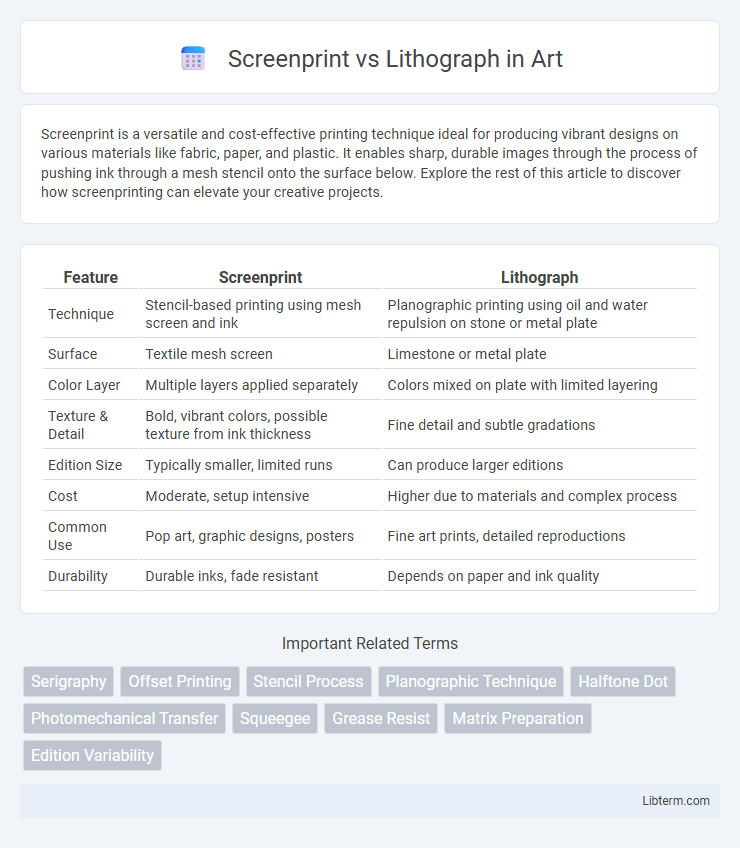Screenprint is a versatile and cost-effective printing technique ideal for producing vibrant designs on various materials like fabric, paper, and plastic. It enables sharp, durable images through the process of pushing ink through a mesh stencil onto the surface below. Explore the rest of this article to discover how screenprinting can elevate your creative projects.
Table of Comparison
| Feature | Screenprint | Lithograph |
|---|---|---|
| Technique | Stencil-based printing using mesh screen and ink | Planographic printing using oil and water repulsion on stone or metal plate |
| Surface | Textile mesh screen | Limestone or metal plate |
| Color Layer | Multiple layers applied separately | Colors mixed on plate with limited layering |
| Texture & Detail | Bold, vibrant colors, possible texture from ink thickness | Fine detail and subtle gradations |
| Edition Size | Typically smaller, limited runs | Can produce larger editions |
| Cost | Moderate, setup intensive | Higher due to materials and complex process |
| Common Use | Pop art, graphic designs, posters | Fine art prints, detailed reproductions |
| Durability | Durable inks, fade resistant | Depends on paper and ink quality |
Introduction to Printmaking Techniques
Screenprint and lithograph are two fundamental printmaking techniques distinguished by their processes and visual outcomes. Screenprinting involves pressing ink through a mesh stencil onto a substrate, enabling bold, vibrant colors and sharp edges ideal for graphic designs. Lithography relies on the repulsion between oil and water, using a flat stone or metal plate to create detailed, textured images with subtle gradations, often favored in fine art prints.
What is Screenprinting?
Screenprinting is a versatile printing technique that involves pushing ink through a mesh stencil, known as a screen, to create bold and vibrant images on various surfaces like paper, fabric, and glass. This method allows for precise color layering and is ideal for producing high-quality prints in limited editions or mass production. Its durability and ability to handle thick inks make screenprinting popular for both artistic and commercial applications.
What is Lithography?
Lithography is a traditional printmaking technique that uses a flat stone or metal plate to create images based on the repulsion of oil and water. Artists draw directly onto the surface with a grease-based medium, which attracts ink while non-image areas repel it after being treated with a chemical solution. This method allows for intricate details and subtle tonal variations, distinguishing lithographs from the bold, vibrant effects typical of screenprints.
History and Origins of Screenprint and Lithograph
Screenprinting originated in ancient China during the Song Dynasty, evolving as a technique of using silk screens to transfer ink onto fabric. Lithography was invented in 1796 by Alois Senefelder in Germany, relying on the principle of oil and water repelling each other to create prints from a flat stone surface. Both techniques revolutionized printmaking by enabling mass production of images, with screenprinting prominent in textiles and lithography in fine art and commercial printing.
Materials and Tools Required
Screenprinting requires a mesh screen, squeegee, stencil, and specialized ink designed for various surfaces like fabric or paper. Lithography involves a limestone or metal plate, greasy drawing materials such as lithographic crayons or tusche, and a chemical etching solution to create the image. Both techniques depend on precise tools for image transfer but differ substantially in their materials and preparation processes.
Process Breakdown: Screenprint vs Lithograph
Screenprint involves pushing ink through a mesh stencil onto a substrate, allowing for vibrant colors and sharp edges with each color applied individually. Lithograph relies on the chemical repulsion of oil and water, transferring ink from a flat stone or metal plate to paper with fine, detailed textures ideal for smooth gradients. Screenprinting is typically used for bold, graphic designs with limited color layers, while lithography excels in reproducing intricate images with subtle tonal variations.
Visual Qualities and Aesthetic Differences
Screenprints exhibit bold, vibrant colors with sharp edges, thanks to the stencil-based printing process that deposits thick layers of ink. Lithographs offer subtler gradients and softer textures due to their foundation on oil and water repulsion on stones or plates, allowing for fine detail and tonal variation. The tactile quality of screenprints often results in a raised ink surface, while lithographs maintain a smooth, flat finish, contributing to distinct aesthetic experiences.
Durability and Longevity of Prints
Screenprints outperform lithographs in durability and longevity due to their thicker layers of ink applied directly onto the surface, which resist fading and wear over time. Lithographs, created with a more delicate ink application on stone or metal plates, tend to be more susceptible to fading, especially when exposed to light and moisture. This makes screenprints ideal for artworks and prints intended to last for decades without significant degradation.
Art Market Value and Collectibility
Screenprints typically hold strong art market value due to their vibrant colors and association with modern artists like Andy Warhol, often resulting in high collectibility and demand. Lithographs, appreciated for their traditional technique and fine detail, attract collectors seeking classic prints, often maintaining steady value in secondary markets. Limited editions of both screenprints and lithographs enhance scarcity, thereby increasing their desirability and market price among serious art collectors.
Choosing Between Screenprint and Lithograph
Screenprint offers vibrant colors and durability, ideal for bold designs and limited editions, while lithograph provides fine detail and smooth gradients suited for traditional art reproductions. Consider the purpose and aesthetic: screenprints excel in graphic intensity and texture, whereas lithographs capture subtle tonal variations with precision. Budget and quantity also influence choice, as screenprints accommodate smaller runs economically, while lithographs are cost-effective for larger editions.
Screenprint Infographic

 libterm.com
libterm.com